10.2.1.4: Simplifying Fractions
- Page ID
- 113224
- Find an equivalent fraction with a given denominator.
- Simplify a fraction to lowest terms.
Introduction
Fractions are used to represent a part of a whole. Fractions that represent the same part of a whole are called equivalent fractions. Factoring, multiplication, and division are all helpful tools for working with equivalent fractions.
Equivalent Fractions
We use equivalent fractions every day. Fifty cents can be 2 quarters, and we have \(\ \frac{2}{4}\) of a dollar, because there are 4 quarters in a dollar. Fifty cents is also 50 pennies out of 100 pennies, or \(\ \frac{50}{100}\) of a dollar. Both of these fractions are the same amount of money, but written with a different numerator and denominator.
Think about a box of crackers that contains 3 packets of crackers. Two of these packets are \(\ \frac{2}{3}\) of the box. Suppose each packet has 30 crackers in it. Two packets are also \(\ 60(30 \cdot 2)\) crackers out of \(\ 90(30 \cdot 3)\) crackers. This is \(\ \frac{60}{90}\) of the box. The fractions \(\ \frac{2}{3}\) and \(\ \frac{60}{90}\) both represent two packets of crackers, so they are equivalent fractions.
Equivalent fractions represent the same part of a whole, even if the numerator and denominator are different. For example, \(\ \frac{1}{4}=\frac{5}{20}\). In these diagrams, both fractions represent one of four rows in the rectangle.

Since \(\ \frac{1}{4}\) and \(\ \frac{5}{20}\) are naming the same part of a whole, they are equivalent.
There are many ways to name the same part of a whole using equivalent fractions.
Let’s look at an example where you need to find an equivalent fraction.
John is making cookies for a bake sale. He made 20 large cookies, but he wants to give away only \(\ \frac{3}{4}\) of them for the bake sale. What fraction of the cookies does he give away, using 20 as the denominator?
Solution
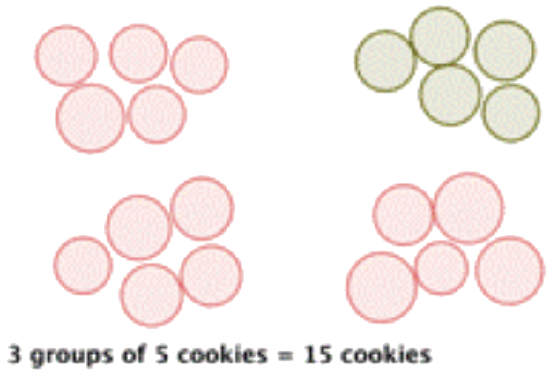 |
Start with 20 cookies. |
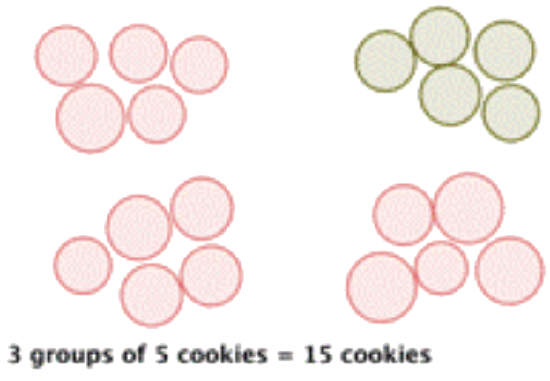 |
Because the denominator of \(\ \frac{3}{4}\) is 4, make 4 groups of cookies, 5 in each group. |
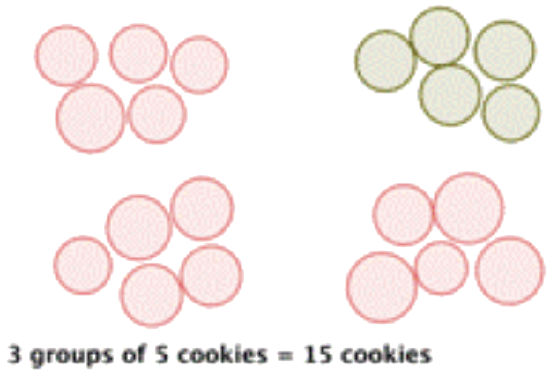 |
\(\ \frac{3}{4}=\frac{3 \cdot 5}{4 \cdot 5}\) because there are 5 cookies in each group. \(\ \frac{3}{4}=\frac{3 \cdot 5}{4 \cdot 5}=\frac{15}{20}\) |
He gives away \(\ \frac{15}{20}\) of the cookies.
When you regroup and reconsider the parts and whole, you are multiplying the numerator and denominator by the same number. In the above example, you multiply 4 by 5 to get the needed denominator of 20, so you also need to multiply the numerator 3 by 5, giving the new numerator of 15.
To find equivalent fractions, multiply or divide both the numerator and the denominator by the same number.
Examples:
\(\ \frac{20}{25}=\frac{20 \div 5}{25 \div 5}=\frac{4}{5}\)
\(\ \frac{2}{7}=\frac{2 \cdot 6}{7 \cdot 6}=\frac{12}{42}\)
Write an equivalent fraction to \(\ \frac{2}{3}\) that has a denominator of 27.
- \(\ \frac{26}{27}\)
- \(\ \frac{11}{27}\)
- \(\ \frac{18}{27}\)
- \(\ \frac{12}{18}\)
- Answer
-
- Incorrect. You may have added the difference between the two denominators to the numerator (27-3=24, 24+2=26). Instead, you need to use a multiplying factor of \(\ 9(27 \div 3)\). The correct answer is \(\ \frac{18}{27}\).
- Incorrect. You may have added the multiplying factor of 9 to the numerator. Instead, multiply the numerator by this factor. The correct answer is \(\ \frac{18}{27}\).
- Correct. The multiplying factor is 9, so the denominator is \(\ 3 \cdot 9=27\) and the numerator is \(\ 2 \cdot 9=18\).
- Incorrect. Although this is an equivalent fraction to \(\ \frac{2}{3}\), the denominator is not 27. The correct answer is \(\ \frac{18}{27}\).
Simplifying Fractions
A fraction is in its simplest form, or lowest terms, when it has the least numerator and the least denominator possible for naming this part of a whole. The numerator and denominator have no common factor other than 1.
Here are 10 blocks, 4 of which are green. So, the fraction that is green is \(\ \frac{4}{10}\). To simplify, you find a common factor and then regroup the blocks by that factor.
Simplify \(\ \frac{4}{10}\).
Solution
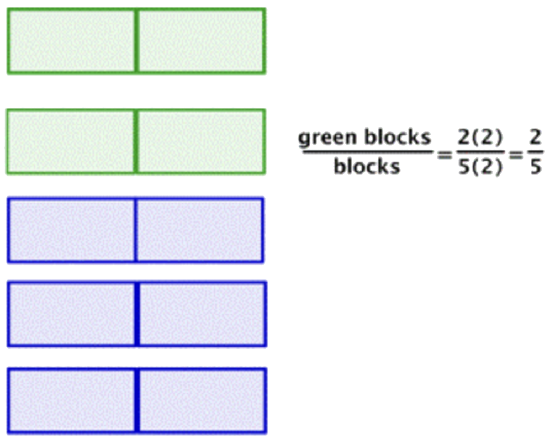 |
We start with 4 green blocks out of 10 total blocks. |
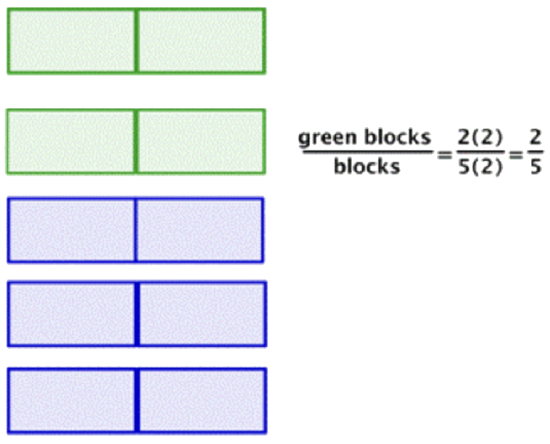 |
Group the blocks in twos, since 2 is a common factor. You have 2 groups of green blocks and a total of 5 groups, each group containing 2 blocks. |
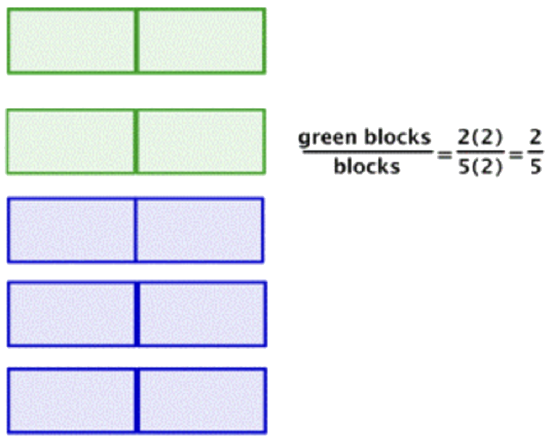 |
Now, consider the groups as the part and you have 2 green groups out of 5 total groups. |
\(\ \frac{4}{10}=\frac{2}{5}\) The simplified fraction is \(\ \frac{2}{5}\).
Once you have determined a common factor, you can divide the blocks into the groups by dividing both the numerator and denominator to determine the number of groups that you have.
For example, to simplify \(\ \frac{6}{9}\) you find a common factor of 3, which will divide evenly into both 6 and 9. So, you divide 6 and 9 into groups of 3 to determine how many groups of 3 they contain. This gives \(\ \frac{6 \div 3}{9 \div 3}=\frac{2}{3}\), which means 2 out of 3 groups, and \(\ \frac{2}{3}\) is equivalent to \(\ \frac{6}{9}\).
It may be necessary to group more than one time. Each time, determine a common factor for the numerator and denominator using the tests of divisibility, when possible. If both numbers are even numbers, start with 2. For example:
Simplify \(\ \frac{32}{48}\).
Solution
| \(\ \frac{32}{48}=\frac{32 \div 2}{48 \div 2}=\frac{16}{24}\) | 32 and 48 have a common factor of 2. Divide each by 2. |
| \(\ \frac{16}{24}=\frac{16 \div 2}{24 \div 2}=\frac{8}{12}\) | 16 and 24 have a common factor of 2. Divide each by 2. |
| \(\ \frac{8}{12}=\frac{8 \div 4}{12 \div 4}=\frac{2}{3}\) | 8 and 12 have a common factor of 4. Divide each by 4. |
| \(\ \frac{32}{48}=\frac{2}{3}\) | \(\ \frac{2}{3}\) is the simplified fraction equivalent to \(\ \frac{32}{48}\). |
In the example above, 16 is a factor of both 32 and 48, so you could have shortened the solution.
\(\ \frac{32}{48}=\frac{2 \cdot 16}{3 \cdot 16}=\frac{2}{3}\)
You can also use prime factorization to help regroup the numerator and denominator.
Simplify \(\ \frac{54}{72}\).
Solution
| \(\ \frac{54}{72}=\frac{2 \cdot 3 \cdot 3 \cdot 3}{2 \cdot 2 \cdot 2 \cdot 3 \cdot 3}\) |
The prime factorization of 54 is \(\ 2 \cdot 3 \cdot 3 \cdot 3\). The prime factorization of 72 is \(\ 2 \cdot 2 \cdot 2 \cdot 3 \cdot 3\). |
| \(\ \frac{3 \cdot(2 \cdot 3 \cdot 3)}{2 \cdot 2 \cdot(2 \cdot 3 \cdot 3)}\) | Rewrite, finding common factors. |
| \(\ \frac{3}{2 \cdot 2} \cdot 1\) | \(\ \frac{2 \cdot 3 \cdot 3}{2 \cdot 3 \cdot 3}=1\) |
| \(\ \frac{3}{4}\) | Multiply: \(\ 2 \cdot 2\). |
| \(\ \frac{54}{72}=\frac{3}{4}\) | \(\ \frac{3}{4}\) is the simplified fraction equivalent to \(\ \frac{54}{72}\). |
Notice that when you simplify a fraction, you divide the numerator and denominator by the same number, in the same way you multiply by the same number to find an equivalent fraction with a greater denominator. In the example above, you could have divided the numerator and denominator by 9, a common factor of 54 and 72.
\(\ \frac{54 \div 9}{72 \div 9}=\frac{6}{8}\)
Since the numerator (6) and the denominator (8) still have a common factor, the fraction is not yet in lowest terms. So, again divide by the common factor 2.
\(\ \frac{6 \div 2}{8 \div 2}=\frac{3}{4}\)
Repeat this process of dividing by a common factor until the only common factor is 1.
To simplify a fraction to lowest terms, divide both the numerator and the denominator by their common factors. Repeat as needed until the only common factor is 1.
Simplify \(\ \frac{36}{72}\).
- \(\ \frac{3}{6}\)
- \(\ \frac{9}{18}\)
- \(\ \frac{18}{38}\)
- \(\ \frac{1}{2}\)
- Answer
-
- Incorrect. Although \(\ \frac{3}{6}\) is an equivalent fraction to \(\ \frac{36}{72}\), it is not in lowest terms. There is a common factor of 3 in the numerator and denominator. The correct answer is \(\ \frac{1}{2}\).
- Incorrect. Although \(\ \frac{9}{18}\) is an equivalent fraction to \(\ \frac{36}{72}\), it is not in lowest terms. There are other common factors (9 and 3). The correct answer is \(\ \frac{1}{2}\).
- Incorrect. You may have divided 72 by 2 and got 38 rather than 36. \(\ \frac{18}{36}\) is an equivalent fraction to \(\ \frac{36}{72}\), but it is not in lowest terms. The correct answer is \(\ \frac{1}{2}\).
- Correct. \(\ \frac{1}{2}\) is in lowest terms, as 1 is the only common factor of 1 and 2.
Summary
Equivalent fractions do not always have the same numerator and denominator, but they have the same value. A fraction is in lowest terms when the numerator and denominator of the fraction share no common factors other than . A fraction written in lowest terms is called a simplified fraction.


